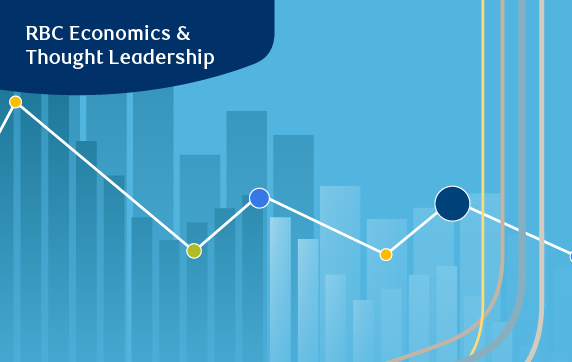Highlights:
- U.S. gross domestic product growth and labour market conditions are finally softening alongside two straight downside inflation surprises. We now expect the U.S. Federal Reserve to cut rates in September—earlier than our prior December assumption—with a gradual easing cycle to follow.
- The Canadian economy is stuck in excess supply with per-capita GDP continuing to decline and unemployment persistently trending higher. Inflation is set to moderate further following slower growth in mortgage and rent costs. We expect three more cuts from the Bank of Canada this year with the overnight rate at 4% by December.
- The economic rebound in the euro area and the U.K. is continuing in Q2 after a softer 2023. But, still elevated services inflation is arguing for a gradual easing cycle from the European Central Bank and Bank of England. We retain our call that the ECB will follow with a second cut in September and the BoE will make a first cut in August.
- In terms of broader implications for the U.S. economy from the November presidential election, we think if Trump is re-elected, his second presidency would look a lot like the first one. There will be another round of potential trade disruptions representing a threat to an already weakening manufacturing sector.
Equity markets continue to trend higher into early July driven by lower perceived risk by investors. Early signs of softening in the U.S. economy have grown clearer as the summer progresses. But investors, for the most part, continue to look past slower growth data, encouraged by bets that headwinds from a gradual updrift in unemployment could be offset by rate cuts by the Fed.
In a testimony to Congress earlier this week, Fed Chair Jerome Powell highlighted a shift in the risk balance away from upside inflationary risks towards rates being restrictive for too long. Indeed, two consecutive downside U.S. inflation surprises in May and June took some of the sting out of the reacceleration in price growth earlier this year. The softening in the economic growth backdrop (U.S. GDP growth is tracking below a 2% rate for a second straight quarter in Q2) also increases the odds that price growth will continue to broadly slow.
Our expectation is still that the U.S. economy will land softly with moderate easing in labour markets and slowing inflation persisting in the quarter ahead. Contingent on that outlook, we look for the Fed to cut the Fed funds target range in September (earlier than our prior forecast for a December cut) with a gradual easing cycle (100 basis points of cuts by the end of 2025 in total) to follow.
In Canada, growth remains sluggish in Q2 as a broad-based GDP gain in April quickly lost steam in May followed by a 0.4% decline in hours worked in June that pointed to further deterioration. May’s inflation data was a small hiccup, but dismal GDP growth is leaving the economy firmly in excess supply. There is plenty of room for further easing from the BoC this year with interest rates still at high levels. We continue to expect 100 basis points of cuts from the BoC this year (including the 25 basis point reduction in June) to leave the overnight rate at 4% by the end of 2024.
Similarly, momentum in GDP growth in the euro area appears to have faded a little after a stronger Q1 with purchasing managers indexes pointing to slowing but still solid activities in both manufacturing and services early in the summer. The U.K., on the other hand, has been bucking that trend with Q2 GDP tracking a second consecutive increase. A bigger headache for the ECB and BoE has been a lack of progress in slowing services inflation. That together with a broad rebound in the economies all argue for a more gradual cutting cycle this time around. We continue to look for another 50 bps of cuts from the ECB this year after the initial reduction in June and for the BOE to start its gradual easing cycle in August with another cut later in Q4.
Central bank bias
Central Bank
Current Policy Rate
(Latest Move)
Next move
 BoC
BoC
4.75%
-25 bps in Jun/24
-25 bps
Jul/24
 Fed
Fed
5.25-5.5%
+0 bps in Jun/24
0 bps
Jul/24
 BoE
BoE
5.25%
+0 bps in Jun/24
-25 bps
Aug/24
 ECB
ECB
3.75%
-25 bps in Jun/24
0 bps
Jul/24
 RBA
RBA
4.35%
+0 bps in Jun/24
0 bps
Aug/24
Is the U.S. economic outperformance fading?
Of all the regions, the biggest change in the latest round of data releases is the emergence of cracks in the exceptional run of U.S. growth. GDP growth is tracking at a sub-2% annualized rate for a second straight quarter in Q2 this year with much of that gain coming from a build in inventories. Real final sales, in the meantime, are tracking little change in Q2 with business investment pulling back and a surge in imports offsetting another increase in consumer spending on services.
Indeed, the two key components that have supported U.S. economic outperformance have been strong services consumption and fiscal tailwinds from a massive government budget deficit. The latter looks likely to persist, regardless of the election result in November and as long as markets are willing to fund it. But, services consumption has been supported by excess pandemic savings that are now depleted. The ISM services for June fell to its lowest level since the pandemic. A pullback in demand means the U.S. unemployment rate has also crept higher over the last year despite stronger hiring at the government level.
Broader macro and labour market conditions as they stand in the U.S. are still solid, especially when interest rates have been restrictive for so long. But recent signs of slowing in U.S. labour market and inflation are also significant, and quite critical to what the Fed’s been waiting to see to confirm that interest rates are restrictive enough to reach their dual mandate. We now look for the first rate cut from the Fed in September—earlier than the December pivot we previously assumed. After that, we look for a shallow easing cycle to follow with 100 basis points of cuts in total by the end of 2025.
Risks of another round of trade disruptions
As November edges closer, and former U.S. president Donald Trump pulls ahead in national election polling, the risk of significant international trade disruptions is coming back into focus. The former president’s ability to pass measures like a promised extension of 2017 tax cuts set to expire in 2025 will depend on the control of Congress. But even in a split government, the president would have substantial, and essentially unilateral, ability to impose tariffs. The hikes to tariffs that Trump has speculated about on the campaign trail, if implemented, could be significantly more disruptive than those from his first term.
Broadly, the tariff hikes imposed during 2018 and 2019 were put in place with the intention to reduce international reliance and minimize unfair competition from foreign producers and importers, especially China. Empirical studies since then, however, have largely found the costs of the tariff increases were paid by U.S. producers and consumers and they haven’t done much to support U.S. manufacturing.
The size of the U.S. trade deficit is little changed as a share of GDP from levels before those earlier tariffs in 2016. The deficit with China has narrowed, but largely due to the reorientation of trade flows to other trade partners in Asia like Vietnam and Thailand. In the meantime, increased input costs have reduced U.S. manufacturers’ competitiveness. At last count in May, U.S. manufacturers produced about as much as they did more than a decade ago in 2013.
With all the back-and-forth and high-profile tariffs imposed on imports from China in those first four years, the average U.S. tariff rate still only increased by about 1.5 percentage points. A 10% tariff on all U.S. imports that Trump has suggested would make it more difficult for trade flows to reorient and would add up to a substantially larger cost than the tariffs imposed in his first administration.
They would be incredibly damaging if imposed across the board on close trading partners like Canada and Mexico—to the point of being implausible in practice. For example, North American auto manufacturers have closely integrated production lines that can work to compound the tariffs because they are taxing trade flows that are multiples of the actual value of end production.
Indeed, components for a vehicle can cross Canadian-U.S.-Mexican borders as many as eight times before reaching the final assembly. That means U.S. imports also effectively include the value of U.S. exports that fed into an earlier stage of production. Interestingly, after accounting for all the re-imports and re-exports, the U.S. effectively is its own third-largest import market when it comes to auto manufacturing. That’s why a 10% unilateral tariff hike on all U.S. imports is almost as implausible as it is harmful. It will effectively force a pause in production among sectors where cross-border production lines are well integrated.
We think a more likely scenario will be an extension to what had been done during Trump’s last term—i.e., targeted tariff hikes covering most or all imports from China. In that scenario, we expect marginally slower growth in the U.S. with small upward domestic price pressures like the impact seen after the 2018 and 2019 tariff hikes, but with relatively limited spillover to Canada.
Easing in shelter costs will lead Canada’s CPI lower
In our forecast, headline consumer price index in Canada is expected to drop lower to levels just above the 2% inflation target by the end of this year. A large part of that will reflect slower growth in shelter, specifically, mortgage interest costs (MIC) as lending rates (that have already begun to moderate) drop further after BoC rate cuts.
The way Statistics Canada includes MIC in the CPI is somewhat unique. MIC in Canada is directly related to the Bank of Canada’s interest rate policy. Due to this, the central bank historically looks through the impact of MIC on measured price growth when thinking about the path of inflation going forward despite MIC accounting for a disproportionate 29% of headline CPI in May.
Excluding MIC, consumer price growth has been running around the BoC’s 2% inflation target since January. By the end of 2024, we expect MIC inflation will drop to around 10% (from 23% in May and a high of 30% in August 2023). That reduction alone should shave about 0.7% off headline CPI growth. By the end of 2025, we expect the yearly growth in MIC will turn negative after most existing mortgages in Canada, having reset to higher interest rates from low levels during the pandemic.
There are also signs that pressures on home rent growth are slowing after surging higher over the last two years due to a lack of housing supply and surging population growth. As of May, rent CPI has surged an annual 8.6%, well above the historical trend rate of 1-1.5% a year. Recent data from posted market rent indexes have flagged early signs of relief with key markets like Vancouver and Toronto seeing declines in asking rents relative to last year.
Shipping cost surges won’t reignite inflation
Risks to lower inflation is a resurgence in global container shipping costs over May and June. The increase has been the culmination of many factors, including disruptions to Red Sea shipping routes (that have lengthened shipping times and reduced spare shipping capacity), port congestion in Asia and an increase in demand ahead of peak ocean shipping season with importers trying to get ahead of shipping delays and potential tariff increases.
Still, the surge in transport prices has yet to show up significantly in industrial prices. Early industry reports are also pointing to some signs of improvements in port congestion in Asia. More importantly, the current global economic and supply chain backdrop is very different than it was during the pandemic. The capacity of container vessel fleet globally has risen steadily over the past years to over 20% above 2019 levels, and is set to increase further this year. That should leave carriers more room to manoeuvre around choke points.
In addition, the current global demand backdrop for goods is still too weak for consumers to be absorbing the price increases in the same way as during the earlier surge in inflation in 2021 and 2022. Even in the outperforming U.S. economy, manufacturing output has contracted for three consecutive quarters. That will continue to limit businesses’ ability to pass on cost increases to consumers, narrowing producer margins rather than propping up prices for final goods on store shelves.
See previous editions of Financial Markets Monthly.

Download the Report
This article is intended as general information only and is not to be relied upon as constituting legal, financial or other professional advice. A professional advisor should be consulted regarding your specific situation. Information presented is believed to be factual and up-to-date but we do not guarantee its accuracy and it should not be regarded as a complete analysis of the subjects discussed. All expressions of opinion reflect the judgment of the authors as of the date of publication and are subject to change. No endorsement of any third parties or their advice, opinions, information, products or services is expressly given or implied by Royal Bank of Canada or any of its affiliates.


 Learn More
Learn More